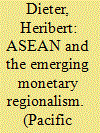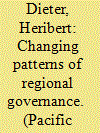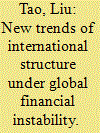| Srl | Item |
| 1 |
ID:
083529


|
|
|
|
|
| Publication |
2008.
|
| Summary/Abstract |
Monetary regionalism - along with bilateral trade agreements - is receiving significant attention in Asia. This article analyzes its development since 2000 with specific reference to the role of ASEAN. It discusses the general rationale for monetary and financial cooperation, the Chiang Mai process, the rivalry between China and Japan, the potential exchange rate regime for the region including monitoring and surveillance, the evolution of regional bond markets, as well as the institutional dimension of monetary regionalism. The analysis confirms that monetary regionalism in Asia will be a complex endeavor and will - if at all - only be achieved in the long run. ASEAN will be able to function as a catalyst for monetary regionalism, but China and Japan are the more important players. Without their (joint) effort, ASEAN will not be able to achieve significant change in monetary and financial affairs.
|
|
|
|
|
|
|
|
|
|
|
|
|
|
|
|
| 2 |
ID:
087562


|
|
|
|
|
| Publication |
2009.
|
| Summary/Abstract |
For decades, international relations in the Asia-Pacific were characterized by an emphasis on security affairs. Following the Asian financial crisis of 1997/98, this pattern has changed. In the early 21st century, policy makers in the region put emphasis on the deepening of economic relations. Both in trade and finance, new patterns of governance have emerged. The reasons are manifold. First, traditional security threats are not as important as they used to be. Second, the experience of 1997/98 as well as the current crisis have demonstrated that economic instability is of greater concern than security threats. Third, the economies of the Asia-Pacific are deepening their ties both at the level of production and with regard to investment flows. Despite these structural changes, the level of cooperation continues to be relatively low.
|
|
|
|
|
|
|
|
|
|
|
|
|
|
|
|
| 3 |
ID:
102994


|
|
|